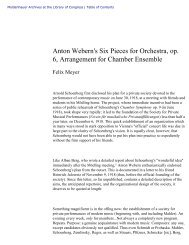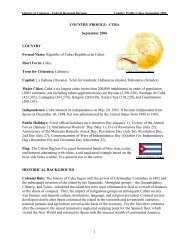1 - American Memory
1 - American Memory
1 - American Memory
You also want an ePaper? Increase the reach of your titles
YUMPU automatically turns print PDFs into web optimized ePapers that Google loves.
169<br />
legislation that will keep our two lifelines open? Is It any wonder that we are<br />
dismayed and disheartened when, faced with one of our lifelines being cut, our<br />
pleas for help go unheeded? Is it any wonder that we feel discriminated against<br />
when other states of the nation are declared disaster areas eligible for special<br />
help as a result of heavy rains or heavy snows while we endure worse disasters<br />
with no relief? Put bluntly, we ask: How come our fleet of Islands can be block-<br />
aded with nobody caring?<br />
The purpose of this study is to contribute to public understanding of this prob-<br />
lem in the hope that it can be corrected.<br />
JOHN D. BELLINGEB,<br />
President, First Hawaiian Bank.<br />
CHAPTEB I—HAWAH'S VTrLNEKABrtiTT TO TBANSPOBTATIOK STRIKES<br />
Apart from her uniquely isolated location, which has already been discussed<br />
ij> the Introduction, Hawaii is particularly vulnerable to transportation strikes<br />
because her economy is preeminently an export-import economy.<br />
Were we largely self-sufficient based upon producing locally the things we con-<br />
sume, then the situation would be different. But it is obviously not economically<br />
feasible nor physically possible for the islands to produce a complete range of<br />
goods for a population of only around 800,000. With the exception of bauxite,<br />
which has never been mined commercially, Hawaii has no metal commercially,<br />
Hawaii has no metal resources. The Islands have few nonmetallic minerals and<br />
no deposits of oil or coal. Land suitable for agriculture is limited and its avail-<br />
ability is shrinking with increasing urban demands. Thus about 80 i)ercent of<br />
all physical commodities purchased by residents of Hawaii come from overseas,<br />
mainly from the Mainland states of the Union.<br />
Let us look at this situation item by Item.<br />
FOOD<br />
Aside from sugar, pineapple, and a few other export crops, agricultural pro-<br />
duction In Hawaii is on a fairly small scale. We depend on imports, mostly from<br />
the Continental I'.S., for a large proportion of the food we con.sume.<br />
Imports account for 52 percent of the beef consumed in the State, 64 percent<br />
of the pork, 75 percent of the chicken, and all of the lamb, mutton, and turkey.'<br />
Although we are largely self-sufficient in fresh milk and eggs, we bring in all of<br />
our butter and margarine, most of it from the Mainland. Even the meat and<br />
dairy products produced locally are ultimately dei)endent on Imports, since<br />
nearly all of our livestock feed comes In from other states.<br />
Some 58 percent of the fresh vegetables marketed In Hawaii are Imported<br />
(nearly all from the West Coast)—including 99 percent of the potatoes, 89 per-<br />
cent of the carrots, 58 percent of the lettuce, and 44 percent of the tomatoes.<br />
And this doesn't include frozen and canned vegetables, all of which are brought<br />
in from outside. The State does produce a variety of tropical fruits, but its im-<br />
ports of such Mainland fruits as oranges, apples, pears, and grapefruit total<br />
more than 31 million pounds a year.<br />
With the exception of corn, no grain Is produced locally for human consump-<br />
tion. Rice occupies much the same position in the Hawaiian diet as potatoes do<br />
In the typical Malnlander's diet. About 55 million pounds of rice are brought<br />
into Hawaii annually, mostly from the Sacramento area. Yearly imports of<br />
around 68 million pounds of Mainland wheat are milled locally to produce 90<br />
percent of the flour consumed in the State, while another 6.6 million pounds of<br />
Mainland-milled flour make up the remaining 10 percent.<br />
In addition to dairy processing and flour milling, food processing in Hawaii<br />
is concentrated largely in the production of sugar, canned pineapple, fruit<br />
juices and preserves, canned fish, bakery products, and some ethnic foods—and<br />
even these industries rely to varying degrees on materials, machinery, and<br />
containers brought in from out.side the State. We are entirely dependent on Im-<br />
ports for such things as cereals, baby foods, soups, cheese (except cottage<br />
cheese), TV dinners, pet food, wine and most hard liquors, cooking oils, most<br />
salt, and an endless list of other food items.<br />
' Figures are for 1970. the mo»t recent year In which Rhlpplng was nnlntermptea.



![Albert Einstein Papers [finding aid]. Library of Congress. [PDF ...](https://img.yumpu.com/21604228/1/190x245/albert-einstein-papers-finding-aid-library-of-congress-pdf-.jpg?quality=85)





![American Colony in Jerusalem Collection [finding aid]. Library of ...](https://img.yumpu.com/17941275/1/190x245/american-colony-in-jerusalem-collection-finding-aid-library-of-.jpg?quality=85)



![Piccard Family Papers [finding aid]. - American Memory - Library of ...](https://img.yumpu.com/17941234/1/190x245/piccard-family-papers-finding-aid-american-memory-library-of-.jpg?quality=85)


